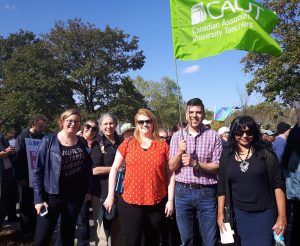
Stronger Together: Achieving Fairness for Contract Academic Staff Conference
Geraldine Eliot, FSA Member
“A Walmart-style education system built on precarious work isn’t good for faculty, and it isn’t good for students.” – Ontario Public Service Employees Union (OPSEU) website
According to the Canadian Association of University Teachers (CAUT), Contract Academic Staff (CAS) account for 1/3 of all professors in Canada. Since 1999, the number of contract staff has risen by 200%, while the number of regular professors has risen only 14%. So, how does the casualization of teaching undermine the profession for all types of faculty? This topic was addressed at CAUT’s Contract Academic Staff committee meeting and the conference for Contract Academic Staff that took place in Toronto from 18-21 October.
As a newly minted member of the CAUT CAS committee and representing the FSA, I was eager to see what issues were being faced by other faculty in Canada and how this relates to our context at BCIT. I was also keen to learn more about the role that CAUT can play in supporting FSA members. CAUT Executive Director, David Robinson (himself a CAS) joined us to talk about CAUT’s role in several court cases around academic freedom and other concerns, the on-site education workshops CAUT provides (e.g. on collective bargaining, grievance handling, intellectual property), and other updates. The committee discussed various initiatives like CAUT’s Get Science Right Campaign, FPSE’s Precarious Profs BC campaign, Fair Employment Week, and more. We also examined the early results of CAUT’s CAS National Survey, looked at federal labour code changes, and discussed updates and “wins” from the different committee members’ organizations. I was left with the impression that by joining CAUT, the FSA has aligned itself with a powerful ally.
CAS Coming Together at the CAUT Conference
A variety of speakers from different universities and colleges across Canada, as well as groups like Fight for $15 and Fairness, addressed the 65+ CAS conference attendees on the changing conditions in academia as more institutes rely on larger numbers of contract faculty over full-time/tenured faculty. Speakers shared their victories and challenges, and panels focused on how to boost CAS’s ability to fight for core employment rights, achieve parity between contract and full-time faculty, and participate in larger public policy discussions.
The first day of the conference was specifically dedicated to exploring issues of bargaining, grievance handling, and mobilization, while Day 2 comprised of hands-on skills training around confronting and solving a common collective agreement-based issue. We were given a specific scenario to respond to and breakout groups worked on ways to create effective campaign materials, deal with grievances and bargaining, and engage with all concerned audiences – from union members, students, and parents to administrators, media, and government. Participants were encouraged to take back these skills to their campuses to help all faculty fight for fairness.
Ongoing Ontario College Faculty Strike
An interesting backdrop to the conference was provided by the current Ontario college faculty strike (lead by the Ontario Public Service Employees Union, OPSEU), now in its third week. In solidarity, CAUT’s CAS committee attended a rally at York University (which shares a campus with Seneca College).During the conference, attendees bussed to Humber College’s Lakeshore campus to join a rally there. James Compton, president of CAUT, was able to speak at both rallies, stressing the need to stand together to end the precarity of all types of academic work and to improve working conditions for post-secondary educators.
Our Working Conditions are Students’ Learning Conditions
As a Part-Time Studies instructor and former full-time temporary instructor at BCIT, I was encouraged to see that CAS issues are being discussed and prioritized. However, a common thread that emerged over the conference and committee meeting was that there are also many shared concerns between regular faculty and CAS. Whether it relates to workload issues, job security, academic freedom, or pay, the casualization of labour is impacting working conditions for all of us and is affecting our students’ learning conditions.
A strong message I heard was that we need to stop repeating the cliché that there’s a divide between CAS and full-time faculty. We need to work together to improve the overall academic profession and stop the privatization and “Walmart-style” changes to academia. Creating a shared vision can ensure we tackle the challenges at BCIT (and beyond) for all instructional staff. We need to look at the state of academia and our institutes as they are now, not what they were, so that we can indeed move forward and be “stronger together”.
Geraldine Eliot has been Communications and Technical Writing instructor at BCIT for 10 years, moving from full-time temporary/contract position to part-time studies. She is a newly appointed representative of the FSA on CAUT’s Contract Academic Staff committee.
Leave a reply →


Great article, Geraldine! Thanks for providing so much detail and insight into the conference. What you’ve written about CAS and regularized faculty needing to work towards a common vision really resonates with me. I look forward to more discussion on this!
Reply →Thanks Andrea! It’s an important conversation we need to keep having, and I believe that PTS and FT working together is the biggest step to ensuring fair working conditions for us all.
Reply →Thank you for writing and sharing this article. The growth in part-time faculty is well documented. Is there also a supporting statistic about the (seemingly) exponential growth in administrators/bureaucrats in the post-secondary systems over the past two decades. It seems as though administration has grown, but permanent faculty has not, despite soaring student numbers and increased class sizes. I hope this conversation keeps going. Thanks again for writing, Geraldine.
Reply →